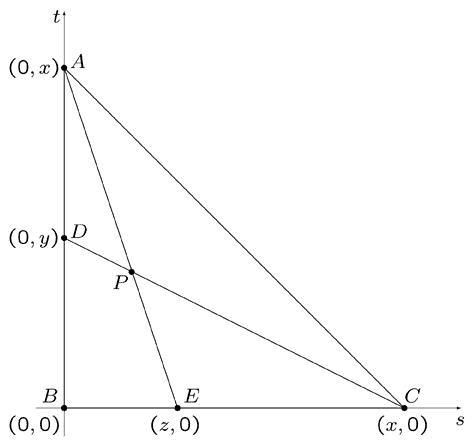tyrant_soul
New member
- Joined
- Nov 26, 2006
- Messages
- 2
I have really tried... I even got help from other forums but I do not understand what to do. One procedure is more confusing than the other... I've tried getting the answer using coordinates to no avail... I am beginning to get desperate.The triangle ABC is an isosceles right triangle, with the angle at B being the right angle. Let E and D be points between B and C, and between B and A, respectively. Let BA = x, BD = y, BE = z, and P be the point of intersection of segments AE and CD. What is the area of triangle APC in terms of x, y, and z? Express your answer as a fraction with its numerator and denominator completely factorized.
Heres what I've tried:
I tried to get the areas of the three triangles and then Subtract them to get only the area of APC But I got all confused when I tried to subtract.
So the area of ABC: X^2/2
Area of DBC: XY/2
Area of ABE: ZX/2
Area of AEC: (X*√2) (X-2) (sinº45)
The area of AEC I got it using a formula from my book.
This is what I've been told:
Unless I'm missing something, problem 2 is really rather hard. The only way I could do it was to use coordinates. Take B as the origin and BA, BC as the coordinate axes. Then you immediately run into a problem about what to call the two variables, since x and y have already been used in the statement of the question. So you need to use different letters, say s for the variable along the horizontal axis and t along the vertical axis. Find the equations of the lines AE and CD, and solve them to find the (s,t)-coordinates of the point P where they intersect. Then area(APC) = area(ABC) – area(APB) – area(BPC), and the two triangles APB, BPC have base x and heights the two coordinates of P. (There may be a better way to do the question than this messy method, but the answer is sufficiently complicated that I doubt it.)
as I didn't get it, I asked once more and they gave me this diagram:

And now, I feel really bad cause even with the diagram I don't get the process. To try to get the answer through coordinates does sound like the most sensible thing... However I don't have any numbers so I cannot get the slope...plus the answer has to be expressed in terms of x y and z...and I don't see how you can get a slope from that.
Another Method:
For the second one, let A(.) be the area of the polygon . So A(ABC) = A(AEB) + A(BCD) + A(APC) - A(BPED) (why?) Most of those areas are simple.
However I cannot get the area of BPED.
